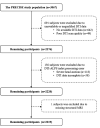Impaired glymphatic system as evidenced by low diffusivity along perivascular spaces is associated with cerebral small vessel disease: a population-based study
- PMID: 37045543
- PMCID: PMC10647865
- DOI: 10.1136/svn-2022-002191
Impaired glymphatic system as evidenced by low diffusivity along perivascular spaces is associated with cerebral small vessel disease: a population-based study
Abstract
Objective: This study aims to investigate the associations of glymphatic system with the presence, severity and neuroimaging phenotypes of cerebral small vessel disease (CSVD) in a community-based population.
Method: This report included 2219 community-dwelling people aged 50-75 years who participated in the PolyvasculaR Evaluation for Cognitive Impairment and vaScular Events cohort. The diffusivity along perivascular spaces based on diffusion tensor imaging (DTI-ALPS index) was measured to assess glymphatic pathway. The presence and severity of CSVD were estimated using a CSVD score (points from 0 to 4) and a modified CSVD score (points from 0 to 4), which were driven by 4 neuroimaging features of CSVD, including white matter hyperintensity (WMH), enlarged perivascular spaces (EPVS), lacunes, cerebral microbleeds. Brain atrophy (BA) was also evaluated. Binary or ordinal logistic regression analyses were carried out to investigate the relationships of DTI-ALPS index with CSVD.
Result: The mean age was 61.3 (SD 6.6) years, and 1019 (45.9%) participants were men. The average DTI-ALPS index was 1.67±0.14. Individuals in the first quartile (Q1) of the DTI-ALPS index had higher risks of the presence of CSVD (OR 1.77, 95% CI 1.33 to 2.35, p<0.001), modified presence of CSVD (odds ratio (OR) 1.80, 95% CI 1.38 to 2.34, p<0.001), total burden of CSVD (common OR (cOR) 1.89, 95% CI 1.43 to 2.49, p<0.001) and modified total burden of CSVD (cOR 1.95, 95% CI 1.51 to 2.50, p<0.001) compared with those in the fourth quartile (Q4). Additionally, individuals in Q1 of the DTI-ALPS index had increased risks of WMH burden, modified WMH burden, lacunes, basal ganglia-EPVS and BA (all p<0.05).
Conclusion: A lower DTI-ALPS index underlay the presence, severity and typical neuroimaging markers of CSVD, implying that glymphatic impairment may interact with CSVD-related pathology in the general ageing population.
Trial registration number: NCT03178448.
Keywords: cerebrovascular circulation; cerebrovascular disorders; cognitive dysfunction; magnetic resonance imaging; stroke.
© Author(s) (or their employer(s)) 2023. Re-use permitted under CC BY-NC. No commercial re-use. See rights and permissions. Published by BMJ.
Conflict of interest statement
Competing interests: None declared.
Figures





References
Publication types
MeSH terms
Associated data
LinkOut - more resources
Full Text Sources
Medical
